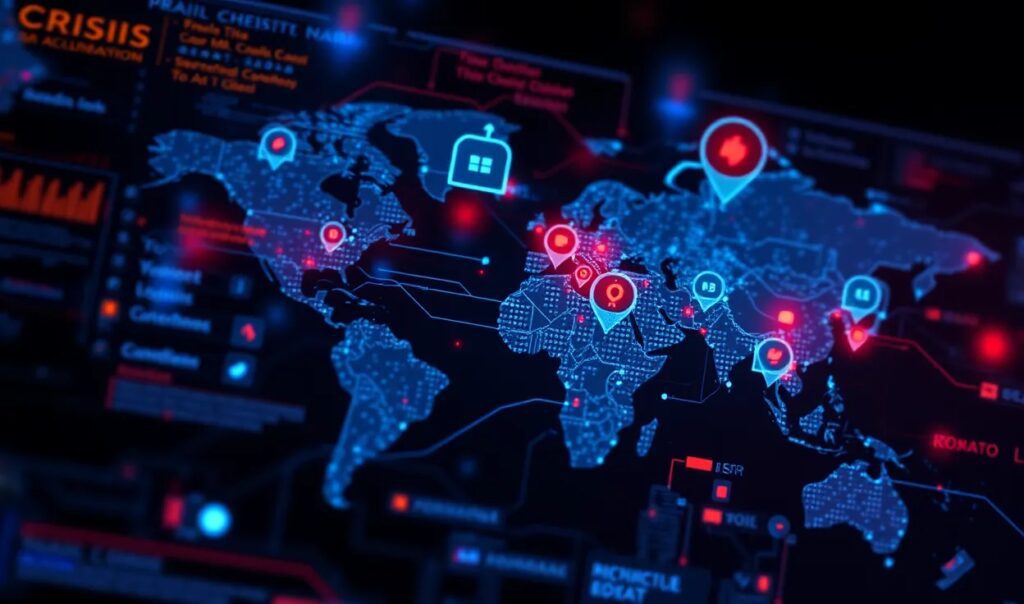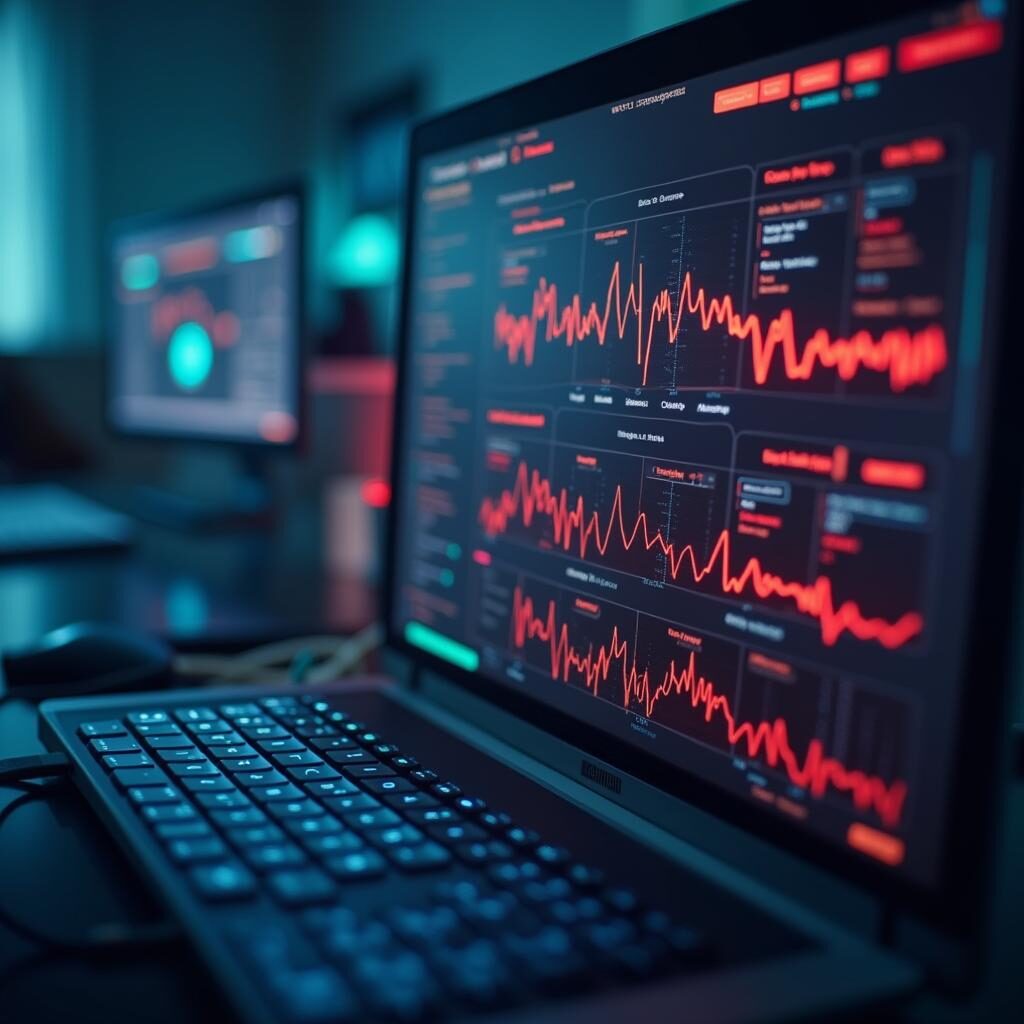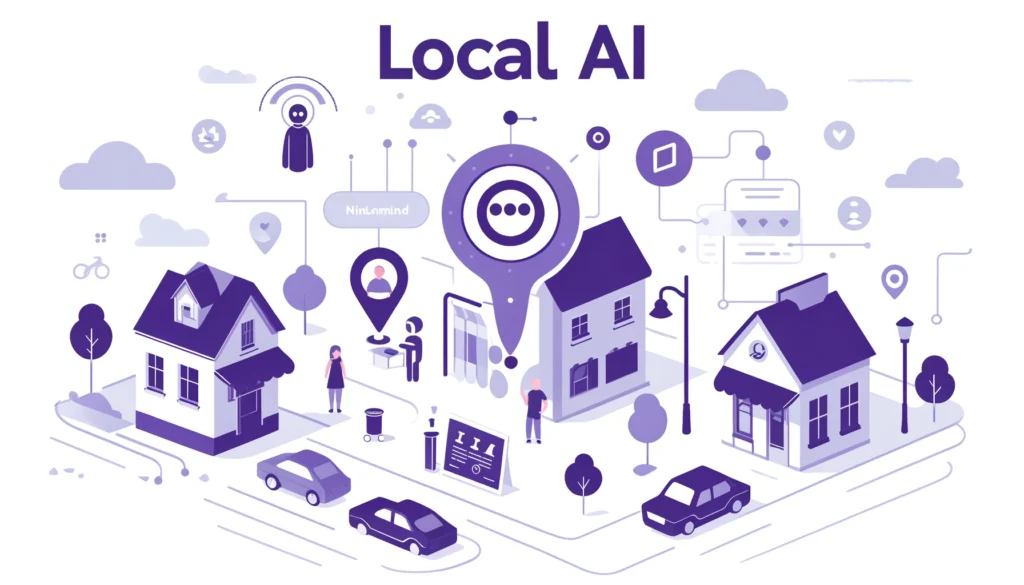
Staying informed during an emergency is critical, but traditional alerts often fail to provide timely, actionable information. Enter AI-powered real-time crisis alerts, a technology that transforms your living room into a control center for personal safety.
Let’s explore how these innovations are reshaping emergency response.
What Are Real-Time AI Crisis Alerts?
Defining Real-Time AI Alerts
AI-driven crisis alerts analyze vast amounts of data instantly to deliver relevant updates directly to you. Unlike older systems, they leverage machine learning to predict patterns and improve accuracy.
For example, when a wildfire threatens a neighborhood, these alerts provide location-specific evacuation routes within seconds, not hours.
How They Work in Your Living Room
Real-time alerts can integrate with smart devices like TVs, voice assistants, and phones. Imagine hearing a calming, authoritative voice say:
“Flood warning in your area. Prepare to evacuate to higher ground.”
These systems pull from sources such as:
- Weather radar data
- Social media reports
- Government feeds like FEMA alerts
The Role of AI in Emergency Preparedness
AI-Powered Prediction and Prevention
Modern AI doesn’t just report emergencies—it predicts them. Algorithms analyze seismic activity, extreme weather, and even human patterns to warn about impending events like earthquakes or riots.
Communities using AI for preparedness are seeing fewer injuries during emergencies. It’s proactive safety, not just reactive action.
Personalizing Alerts for Relevance
Generic alerts are a thing of the past. AI tailors updates based on your:
- Location
- Known health concerns (e.g., asthma for wildfire smoke)
- Family composition (e.g., children or elderly relatives requiring special care)
Smart Devices as the Core of Your Alert Network
TVs: The Command Center
Modern smart TVs double as real-time crisis hubs, displaying evacuation maps, live video feeds, and ongoing updates.
Example: During hurricanes, televisions can switch automatically to local storm tracking channels when a warning is issued.
Voice Assistants: Your Digital First Responder
Devices like Alexa or Google Assistant provide hands-free information during crises. They can:
- Dial emergency numbers.
- Offer survival instructions (like how to shelter in place).
- Update you on first responder arrival times.
Challenges in Deploying AI Crisis Systems
Privacy Concerns
AI collects data for accuracy, but what happens to your personal information during and after emergencies? Developers must implement strict privacy policies.
False Positives and Alert Fatigue
Over-alerting can desensitize users. AI systems need to balance urgency with accuracy, avoiding unnecessary panic.

AI Integration: Transforming Traditional Alerts
Beyond SMS and Sirens
Traditional alerts like text messages and sirens have limitations—they’re loud but lack detail. AI-enhanced systems deliver real-time, actionable data to keep you better informed.
For instance, an AI-powered system might suggest:
- The fastest evacuation routes during a fire.
- Nearby shelters with available space.
- Medical tips tailored to your needs, like handling asthma during a smoke advisory.
Multi-Platform Accessibility
AI systems integrate seamlessly with wearables, apps, and home automation devices, ensuring no one misses vital updates. Even if you’re away from home, your smartwatch or phone keeps you in the loop.
Revolutionizing Disaster Response with AI
The Role of AI in Coordinating First Responders
AI doesn’t just notify civilians; it also optimizes emergency responder coordination. During a crisis, AI systems analyze:
- Road blockages to determine optimal ambulance routes.
- Real-time conditions like wind speed for firefighting strategies.
- Patterns of distress calls to deploy resources effectively.
By bridging the gap between local governments, first responders, and residents, AI ensures that help arrives where it’s needed most—fast.
Virtual Crisis Simulations for Training
AI-powered simulations allow agencies to train for real-world emergencies. These virtual drills simulate:
- Natural disasters like earthquakes or floods.
- Industrial accidents, including chemical spills.
- Large-scale evacuation procedures.
This hands-on training ensures greater preparedness during actual events.
AI Beyond Emergencies: Everyday Safety Applications
Routine Alerts to Stay Ahead
While critical for emergencies, AI alert systems also serve day-to-day needs, like:
- Reminders to avoid high-traffic areas.
- Notifications of approaching severe weather.
- Monitoring air quality for sensitive populations.
These alerts blend seamlessly with daily life, keeping safety at the forefront without being intrusive.
Empowering the Vulnerable
AI systems ensure inclusivity by catering to those with unique needs:
- Text-to-speech alerts for the visually impaired.
- Customized evacuation plans for individuals with mobility challenges.
- Alerts in multiple languages to serve diverse communities.

Overcoming the Challenges Ahead
Building Trust in AI Systems
For AI alerts to be effective, people must trust their accuracy. Governments and tech companies are working together to increase transparency by:
- Clearly explaining how alerts are generated.
- Sharing success stories to highlight effectiveness.
- Continuously refining algorithms based on user feedback.
Ensuring Equity in Access
Not everyone has access to the latest tech. Bridging this gap is essential for universal safety. Community initiatives and subsidies aim to provide affordable AI-integrated devices for underserved populations.
These cutting-edge AI systems are changing the game for safety and disaster preparedness. By leveraging technology, we can build a world that’s not only informed but also resilient.
Installing an AI-powered crisis alert system for your living room depends on the specific devices and platforms you choose. Here’s a step-by-step guide to get you started:
Step 1: Choose Your AI Alert Platform
Popular Platforms and Devices
- Smart TVs: Look for models that integrate with AI alert apps or emergency channels (like Samsung SmartThings or LG’s ThinQ).
- Voice Assistants: Amazon Alexa, Google Assistant, or Apple’s Siri offer AI-driven alert features.
- Mobile Apps: Download apps like FEMA, Red Cross Emergency, or private AI systems like Earthquake Alert! or AccuWeather.
Step 2: Set Up Your Devices
Smart TV Integration
- Connect your TV to Wi-Fi and log in to your account.
- Download an emergency alert app if available (e.g., Weather Nation or MyRadar).
- Enable push notifications and ensure the TV is synced with your smart home network.
Voice Assistant Setup
- Open your assistant’s app (Alexa, Google Home, etc.) and navigate to Skills or Actions.
- Search for emergency alert services (e.g., FEMA Skill on Alexa).
- Activate the service and configure preferences, like specific alerts for weather, fires, or earthquakes.
Smartphone App Setup
- Visit the app store on your device and install a trusted alert system.
- Allow permissions for location services for real-time, geo-targeted notifications.
- Set preferences, like types of alerts and notification sounds.
Step 3: Customize Alerts for Your Needs
- Location Settings: Add your home address and additional locations you care about (e.g., work or family homes).
- Alert Types: Choose what matters most—weather, health hazards, crime, or all-in-one solutions.
- Device Syncing: Connect multiple devices (e.g., your phone, smartwatch, and smart TV) for redundancy.
Step 4: Test the System
- Run a test alert if the platform allows it. This ensures all devices are functioning properly.
- Confirm that notifications appear promptly on your devices.
- Adjust sound and display settings for easy recognition during real emergencies.
Step 5: Keep Systems Updated
- Regularly update your apps and devices to access the latest features.
- Check for new integrations or added capabilities like hyper-local alerts or expanded language options.
The Future of Real-Time Alerts
Hyper-Localized Warnings
Emerging AI technology focuses on hyper-local notifications, providing block-by-block updates during events like flash floods or gas leaks.
These advancements allow for safer, quicker decision-making, reducing casualties and property damage.
AI as a Community Tool
AI is also enhancing community resilience, allowing neighborhoods to:
- Share real-time data through connected apps.
- Coordinate evacuation plans.
- Provide mutual aid during crises.
FAQs
Do these systems work offline or during power outages?
Most AI systems require an internet connection to function. However, many platforms have backup options:
- Mobile apps often store limited emergency data offline.
- Devices like voice assistants can switch to battery-powered backup modes.
For example, the FEMA app downloads emergency tips and evacuation maps for offline use. Pairing this with a battery backup or generator can help you stay informed during blackouts.
How secure is my personal data with these systems?
AI crisis alerts prioritize security, but the level of privacy depends on the platform. Look for systems that follow strict encryption protocols and don’t share your data without consent.
For instance, platforms like Google Assistant and Alexa allow you to review and delete stored data through their privacy settings. Always read privacy policies before enabling location tracking or health-related alerts.
Can I use AI alerts for workplace safety?
Absolutely! Many businesses use AI-based platforms to enhance employee safety.
For example, during a chemical spill in a manufacturing plant, the system can alert workers in specific zones to evacuate while others shelter in place. Apps like Everbridge are designed specifically for corporate emergency management.
What devices are compatible with AI alert systems?
AI crisis alerts are versatile and work with:
- Smartphones (iOS and Android)
- Smart TVs (with apps or built-in capabilities)
- Voice assistants like Alexa or Google Assistant
- Wearables like smartwatches
For example, your smartwatch might vibrate to warn of an approaching thunderstorm, while your smart TV displays evacuation maps in real time.
Can AI systems detect emergencies faster than traditional methods?
Yes, AI systems often outperform traditional alerts due to their ability to process massive amounts of data instantly.
For example, during a flash flood, AI can combine weather radar data with traffic conditions to issue faster and more precise warnings than conventional sirens or broadcasts.
Are there costs associated with these systems?
Some services are free, such as the FEMA app or basic notifications from voice assistants. However, premium systems offering advanced features (e.g., hyper-local alerts or multi-device integration) may charge subscription fees.
For example, a paid service might offer minute-by-minute updates on air quality during wildfires or personalized evacuation routes.
How do I know which platform is best for me?
The best platform depends on your needs and devices. For example:
- If you prioritize weather updates, apps like AccuWeather might be ideal.
- For comprehensive coverage, a system like Alexa integrated with your smart home may offer more features.
Research reviews, features, and compatibility to make an informed choice.
Can AI alert systems integrate with my home security system?
Yes, many modern home security systems support AI integrations.
For example, Ring Alarm and ADT systems can sync with emergency alert platforms. During a natural disaster, your home system might activate cameras or notify you via your security app, giving you real-time visibility even if you’re away.
What makes AI alerts better than regular emergency broadcasts?
AI alerts are faster and more targeted compared to traditional broadcasts.
For instance, instead of a general flood warning across an entire city, AI systems can warn a specific neighborhood and provide localized evacuation routes. This saves time and reduces panic by offering actionable advice tailored to your area.
Do AI crisis alerts cover global emergencies?
Yes, many platforms monitor international crises, including earthquakes, tsunamis, and global health threats.
Apps like MyRadar and Earthquake Alert! track seismic activities worldwide. This is particularly helpful for frequent travelers who need updates about their current or future locations.
Can I get alerts in multiple languages?
Most advanced systems offer multi-language support, ensuring inclusivity for non-native speakers.
For example, the Red Cross Emergency app provides alerts and guides in Spanish, Mandarin, and other languages, making it accessible to diverse communities.
How can AI alerts help during health emergencies like pandemics?
AI systems are highly effective during public health crises.
For example, during the COVID-19 pandemic, many platforms provided:
- Local infection rates and hotspots.
- Alerts for nearby vaccination sites.
- Reminders about mask mandates or quarantine requirements.
These alerts kept people informed and reduced the spread of misinformation.
Can these systems help families with special needs?
Yes, many AI platforms cater to families with specific needs.
For example, during an evacuation:
- Alerts can remind you to pack medical equipment for a family member with diabetes or asthma.
- Systems like Alexa can read evacuation steps aloud for visually impaired users.
By tailoring guidance, these tools ensure everyone stays safe and prepared.
Do AI systems work for rural or remote areas?
Some systems work better than others in remote areas, depending on their data sources.
Apps like Zello (a walkie-talkie app for emergencies) are popular in rural communities where cellular or internet service might be weak. AI also helps identify under-resourced areas and prioritize aid deployment.
What happens if I miss an alert?
Most systems allow alerts to be replayed or stored for later reference.
For instance, if you miss a tornado warning on your phone, your smart TV or voice assistant may still display or read out the notification. Many apps also offer reminders until you acknowledge the alert.
Are AI crisis alerts suitable for children or the elderly?
Yes, AI systems can provide age-appropriate guidance.
For children, apps like Ready Kids offer simplified steps for emergencies. For seniors, voice assistants like Alexa can deliver clear instructions without requiring a smartphone, ensuring ease of use.
How reliable are these systems during high-traffic events?
AI systems are designed to scale and handle large volumes of users during widespread emergencies.
For example, during a hurricane, platforms prioritize delivering essential updates without delay, even as millions of users access the system simultaneously. This reliability often surpasses traditional communication channels.
Can I contribute to improving AI alerts?
Yes, many platforms welcome user input to refine their systems.
For instance, apps like Citizen allow users to report incidents in real time, helping improve the accuracy and coverage of alerts. Similarly, feedback on false positives helps fine-tune algorithms for better performance.
Resources
Official Platforms and Tools
- FEMA Mobile App: Provides emergency alerts, shelter locations, and safety tips for the U.S.
- Red Cross Emergency App: Offers multi-hazard alerts and guides for natural disasters and medical emergencies.
- Ready.gov: A U.S. government resource for preparing for and responding to emergencies, with advice on using tech effectively.
Smart Device Guides
- Amazon Alexa Emergency Skills: Browse and activate Alexa skills for emergency updates, like severe weather warnings or disaster readiness.
- Google Assistant Emergency Features: Learn how to set up critical notifications and ask for emergency information.
- Samsung SmartThings: Guide for integrating your smart home devices, including real-time alert functionalities.
Mobile Apps and Websites
- MyRadar: A weather app with emergency alerts and live radar. Ideal for tracking storms and other extreme conditions.
- Earthquake Alert!: Tracks earthquakes globally and sends real-time notifications.
- AccuWeather: Offers severe weather updates, forecasts, and emergency information.
Community and Safety Networks
- Nextdoor: A hyper-local app for neighborhood updates, including crime reports and emergency information shared by locals.
- Citizen App: Real-time alerts about nearby emergencies, from wildfires to police activity.
Educational and Support Resources
- IFRC Preparedness Center: Insights into disaster preparedness, including the use of technology and AI.
- World Meteorological Organization (WMO): Updates on global weather monitoring systems and alerts.

